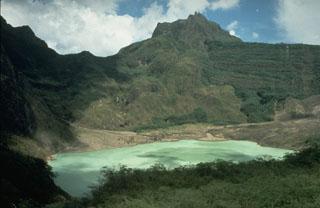Report on Kelud (Indonesia) — November 1996
Bulletin of the Global Volcanism Network, vol. 21, no. 11 (November 1996)
Managing Editor: Richard Wunderman.
Kelud (Indonesia) Crater lake temperature about 4°C above normal
Please cite this report as:
Global Volcanism Program, 1996. Report on Kelud (Indonesia) (Wunderman, R., ed.). Bulletin of the Global Volcanism Network, 21:11. Smithsonian Institution. https://doi.org/10.5479/si.GVP.BGVN199611-263280
Kelud
Indonesia
7.935°S, 112.314°E; summit elev. 1730 m
All times are local (unless otherwise noted)
Around September it was noted that the water temperature in this stratovolcano's crater lake increased from 45.6 to 47.0°C. This is several degrees warmer than the typical water temperature of 43.0°C. Thin white plumes escaped from several areas around the lake in association with the temperature increase. Volcanic earthquakes were absent in September.
Although relatively small and infrequently reported on . . . Kelut has produced some of Indonesia's most deadly eruptions. Multiple historical eruptions have had Volcano Explosivity Index values of 3 to 4. A 1586 eruption may have had a VEI of 5; an estimated 10,000 people died in lahars. There have been 10 fatal crater lake eruptions. Drainage tunnels to control the lake level have greatly reduced the destructive impact of recent eruptions. Kelut's 1000 AD eruption is the oldest historically recorded in Indonesia.
Geological Summary. The relatively inconspicuous Kelud stratovolcano contains a summit crater lake that has been the source of some of Indonesia's most deadly eruptions. A cluster of summit lava domes cut by numerous craters has given the summit a very irregular profile. Satellitic cones and lava domes are also located low on the E, W, and SSW flanks. Eruptive activity has in general migrated in a clockwise direction around the summit vent complex. More than 30 eruptions have been recorded since 1000 CE. The ejection of water from the crater lake during the typically short but violent eruptions has created pyroclastic flows and lahars that have caused widespread fatalities and destruction. After more than 5,000 people were killed during an eruption in 1919, an engineering project to drain the crater lake lowered the surface by more than 50 m. The 1951 eruption deepened the crater by 70 m, leaving 50 million cubic meters of water after the damaged drainage tunnels were repaired. Following more than 200 deaths in the 1966 eruption, a new deeper tunnel was constructed, and the lake's volume before the 1990 eruption was only about 1 million cubic meters.
Information Contacts: Wimpy S. Tjetjep, Volcanological Survey of Indonesia, Jalan Diponegoro No. 57, Bandung 40122, Indonesia.

